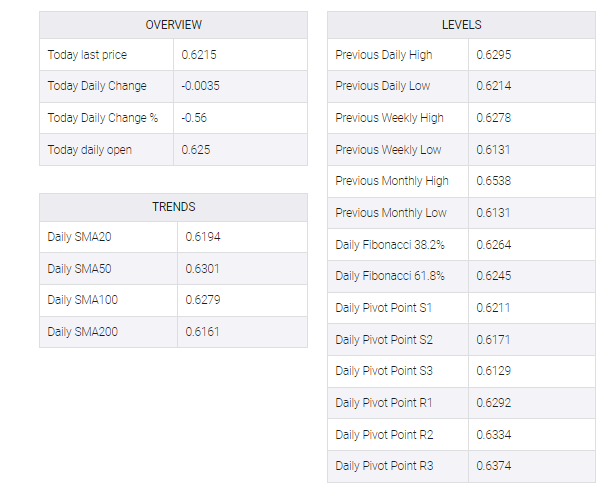-
NZD/USD comes under renewed selling pressure on Friday amid ongoing USD recovery.
-
A fresh leg down in the equity markets benefits the buck and weighs on the risk-sensitive Kiwi.
-
The Fed’s less hawkish stance, sliding US bond yields could cap any further gains for the USD.
The NZD/USD pair extends the overnight pullback from the vicinity of the 0.6300 mark, or its highest level since February 16 and witnesses some follow-through selling on the last day of the week. The downward trajectory picks up pace during the first half of the European session and drags spot prices to a fresh daily low, closer to the 0.6200 round figure in the last hour.
The US dollar (USD) is gaining positive traction for a second day on Friday and recovering further from the seven-week low touched earlier in the day, which in turn, is weighing on the NZD/USD pair. As investors digested the Federal Reserve’s less dovish outlook, a fresh leg down in equity markets sent some haven flows to the greenback and put pressure on risk-sensitive Kiwis.
Against a backdrop of concerns about a full-blown banking crisis, the disappointing release of the flash German manufacturing PMI for March reignited fears of a deep global economic recession. This, in turn, affects global risk sentiment and increases demand for traditional safe-haven assets, including bucks. That said, hints of a pause in Fed interest rate hikes could cap gains for the USD.
It is worth recalling that the US central bank, as widely expected, hiked interest rates by 25 bps on Wednesday, although sounding cautious given the recent turmoil in the banking sector. Additionally, the Fed lowered its median forecast for real GDP growth projections for 2023 and 2024. This leads to further declines in US Treasury bond yields and should act as a headwind for the greenback.
This, in turn, warrants some caution before positioning for an intraday depreciating move for the NZD/USD pair. Even from a technical perspective, the recent two-way range bound price action witnessed over the past two weeks or so also points to indecision over the next leg of a directional move. The base of the sideways range is actually at just below 0.6200 suggesting the pair may find support and begin a new leg higher if the range extends. That said, repeated failures to find acceptance above the 200-day Simple Moving Average (SMA) favour bearish traders and could see a breakout lower.
Market participants now look forward to the US economic docket, featuring the release of Durable Goods Orders and flash PMI prints later during the early North American session. This, along with the US bond yields, might influence the USD and provide some impetus to the NZD/USD pair. Traders will further take cues from the broader risk sentiment to grab short-term opportunities on the last day of the week.


